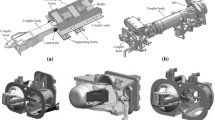Abstract
In-train stability of railway vehicles has becoming a major concern for railway vehicles, which refers to the jackknifing behavior of couplers under large in-train forces. For the train to train rescue scenario, braking induced impacts from couplers can adversely affect the dynamic performance of the coupled train. It is indicated from field tests that in-train forces if combined with large rotational angles of couplers can produce vertical components, which will further lead to the interference of adjacent carbodies and structural damages. In this paper, the dynamic model of the train and coupler system is developed. The model verifications are conducted by comparing the calculated responses with the tested results. The safety indices are formulated on the basis of which the running safety of the coupled train is evaluated. The propelling test in the laboratory is conducted to reproduce the coupler jackknifing behavior. The quasi-static analysis and anti-jackknifing mechanism under compressing in-train forces are analysed. Parametric studies are then conducted to propose some limitations for the application of train to train rescue. It is indicated from numerical and testing results that the decrease of the braking deceleration or a limitation of the free rotational angle of couplers is beneficial to lower the amplitude of braking induced impacts.
Similar content being viewed by others
References
R. C. Li, Unified design for draught-gear for electric multiple unit, Urban Mass Transit, 16 8 (2013) 64–69.
K. Chen and Q. Qian, Test and research on mutual rescue between multiple units of different types, Rolling Stock, 52 5 (2014) 1–5.
D. Chen, Derailment risk due to coupler jack-knifing under longitudinal buff force, Proceedings of the Institution of Mechanical Engineers, Part F: Journal of Rail and Rapid Transit, 224 5 (2010) 483–490.
G. M. Magee, W. M. Keller and R. Ferguson, Jackknifing of diesel electric locomotives report of the joint committee on relation between track and equipment, Report No.10838, Association of American Railroads (AAR), Washington DC, USA (1955).
M. El-Sibale, Recent advancements in buff and draft testing techniques, Proceedings of 1993 IEEE/ASME Joint Conference, ASME, NewYork, USA (1993) 115–119.
M. McClanachan et al., An investigation of the effect of bogie and wagon pitch associated with longitudinal train dynamics, Proceedings of the 16th IAVSD Symposium, Pretoria, South Africa (1999).
S. Wagner, Derailment risk assessment, James Goldston Faculty of Engineering and Physical Systems, Central Queensland University (2004).
C. Cole and Y. Q. Sun, Simulated comparisons of wagon coupler systems in heavy haul trains, Proceedings of the Institution of Mechanical Engineers, Part F: Journal of Rail and Rapid Transit, 220 3 (2006) 247–256.
C. Cole et al., Wagon instability in long trains, Vehicle System Dynamics, 50 1 (2012) 303–317.
Q. Wu et al., Coupler jackknifing and derailments of locomotives on tangent track, Vehicle System Dynamics, 51 11 (2013) 1784–1800.
Z. Q. Xu et al., Coupler rotation behaviour and its effect on heavy haul trains, Vehicle System Dynamics, 51 12 (2013) 1818–1838.
S. H. Luo, Q Feng and J. J. Yang, Research on dynamics of the HXD2 heavy locomotive bearing longitudinal compressive strength, Railway Locomotive & Car, 28 (2008) 145–149.
W. H. Ma, S. H. Luo and R. Song, Coupler dynamic performance analysis of heavy haul locomotives, Vehicle System Dynamics, 50 9 (2012) 1435–1452.
M. El-Sibaie and T. T. Center, Dynamic buff and draft testing techniques, Association of American Railroads Transportation Test Center (AAR/TTC) (1992).
AS 7509.2, Railway rolling stock-dynamic behaviour -part 2: Freight Rolling Stock, Australia and Rail Industry Safety & Standards Board, Canberra, Australia (2009).
BS EN 14363, Railway applications-testing for the acceptance of running characteristics of railway vehicles-testing of running behavior and stationary tests, CEN, Brussels (2005).
UIC 530-2, Wagons -Running Safety, 7th ed., International Union of Railways, Paris (2011).
TSI 2008/232/CE, Concerning a technical specification for interoperability relating to the ‘rolling stock’ sub-system of the trans-European high-speed rail system, Official Journal of the European Union (2008).
N. Nakano and Y. Terumichi, Numerical analysis for coupled train considering 3D wheel/rail contact geometry, Journal of Mechanical Science and Technology, 29 7 (2015) 2677–2683.
Q. Wu et al., Dynamics simulation models of coupler systems for freight locomotive, Journal of Traffic and Transportation Engineering, 12 3 (2012) 37–43.
L. Wei et al., Indirect method for wheel-rail force measurement and derailment evaluation, Vehicle System Dynamics, 52 12 (2014) 1622–1641.
GB 5599-85, Railway vehicles-specication for evaluation the dynamic performance and accreditation test, 1st ed., National Bureau of Standard, Beijing, China (1985).
H. Esfandiar and M. H. Korayem, Accurate nonlinear modeling for flexible manipulators using mixed finite element formulation in order to obtain maximum allowable load, Journal of Mechanical Science and Technology, 29 9 (2015) 3971–3982.
X. Xu, S. Dong, J. Luo and T. Luo, The nonlinear effects of flexible pins on wind turbine gearboxes, Journal of Mechanical Science and Technology, 29 8 (2015) 3077–3082.
J. S. Koo and H. S. Oh, A new derailment coefficient considering dynamic and geometrical effects of a single wheelset, Journal of Mechanical Science and Technology, 28 9 (2014) 3483–3498.
C. J. Park and G. Gschwendtner, Braking performance analysis of an escalator system using multibody dynamics simulation technology, Journal of Mechanical Science and Technology, 29 7 (2015) 2645–2651.
Author information
Authors and Affiliations
Corresponding author
Additional information
Lai Wei received his doctor degree in vehicle operation engineering from Southwest Jiaotong University in 2015. He is interested in the areas of numerical calculation, laboratory experiments and field testing for railway vehicles.
Rights and permissions
About this article
Cite this article
Wei, L., Zeng, J. & Wang, Q. Investigation of in-train stability and safety assessment for railway vehicles during braking. J Mech Sci Technol 30, 1507–1525 (2016). https://doi.org/10.1007/s12206-016-0304-5
Received:
Revised:
Accepted:
Published:
Issue Date:
DOI: https://doi.org/10.1007/s12206-016-0304-5




